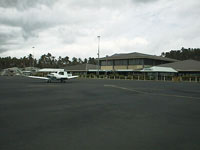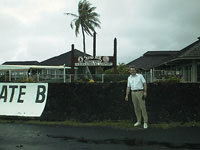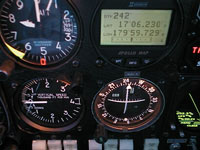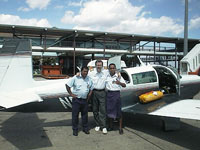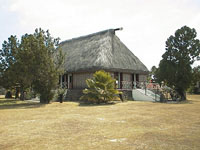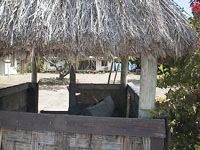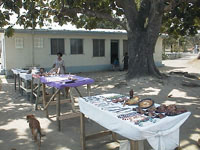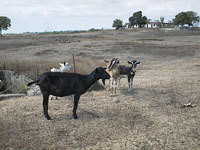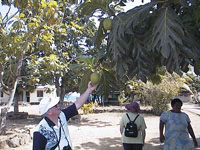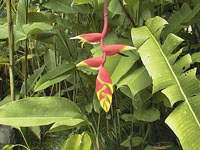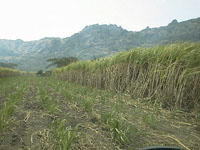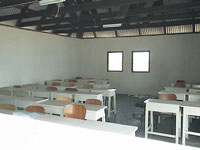![[image map, use itinerary]](/grphx/n_globe.gif) |
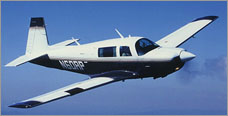 |
|
|
|
|
via Pago Pago, American Samoa As reported earlier, my flight planning service, Jeppesen Dataplan International, had been advised by fax before I left Hawaii that Faleolo Airport in Apia, Western Samoa had avgas, so it was OK for me to go directly there. That was great news to me, since the tour books I had been reading had all strongly recommended visiting Western Samoa rather than nearby American Samoa, given a choice. None of the professional transpacific ferry pilots I consulted had ever followed this advice, however. Their job is to get planes delivered across the ocean as quickly and cheaply as possible, and American Samoa is said to provide a very fast turnaround for American residents as far as paperwork is concerned. The hotels are also cheaper there. However, for me that was the rub. The only "decent" hotel in American Samoa is the government owned Rainmaker hotel, and less than a third of its rooms are considered by typical tourists to be habitable, which is (according to the ferry pilots) being generous. Western Samoa, on the other hand, has beautiful, if somewhat more expensive hotels. It also lacks the smelly tuna canneries that have polluted Pago Pago's harbor and reportedly spread an unattractive odor over the entire side of the island when the wind blows the in the right (wrong?) direction. Finally, Western Samoa retains an almost "pure" Samoan culture, making it the most untouched example of Polynesian life anywhere. For all these reasons I preferred to go there. As reported earlier, it turned out that the promise of avgas availability in Western Samoa was, at best, quite misleading. I therefore had to depart Apia without refueling, fly east to Pago Pago (pronounced PAN-go PAN-go) in American Samoa for gas, and then turn back westbound toward Fiji, overflying W. Samoa as I went. Everything turned out OK once I finally got airborne from Apia, but I learned first hand why the ferry pilots avoid Apia. It took me two hours to wade through an archaic bureaucracy to get permission to depart Apia. I even had to get three different members of the American Embassy staff on the phone to help me convince the W. Samoan officials that all of my customs papers were in order. The Western Samoans had apparently never seen a private plane from the USA before, and couldn't understand why US customs hadn't provided me with an exit visa and a signed general declaration before leaving the States. (We often forget that the USA is one of the few countries that allows its citizens to depart from any port without first getting a customs exit signoff. There are no such documents for our citizens as they leave home.) Anyway, the Samoans hadn't heard of this, and raised quite a fuss. Finally, with embassy help we convinced them, and although they did NOT then give me the appropriate documents that I would need for leaving THEIR country, I didn't stay around to argue. I just jumped in the Mooney, started it up, and took off as quickly as I could before anyone could have a change of heart! The flight to Pago Pago was positively fascinating. . . something out of the 1950's. There is no ATC radar available, and conditions were IFR, with all aircraft in the area flying in the clouds. We all had to continually report our respective positions on the radio to Pago Pago tower to avoid traffic conflicts, something I was trained to do back in the 1970's but have never actually had to use in real life in the States. There were a lot of small turboprop airliners flying tourists back and forth among the islands, so we were all pretty busy communicating, navigating, and aviating, all at once. At least the airliners had copilots to help! The landing at Pago Pago was on a nice long runway, but with strong gusty crosswinds. Interestingly, the instrument approach chart warned of waves breaking over the runway under certain wind conditions, and I remember chuckling over that ridiculous notation. Well, it was true! When I broke out of the clouds, I saw that the runway stretched right out into the ocean, built up only a few feet over the water surface. Sure enough, waves were crashing against the seawall on the upwind side of the runway, spewing spray at least 20 feet into the air. Thankfully, the waves weren't quite high enough to actually flood the runway, but since I was light (low on fuel) anyway, I slammed on the brakes to stop as quickly as possible and get onto a taxiway a little further away from that ominous surf. Again, the ferry pilots' arguments for American Samoa were vindicated by the impressive lack of paperwork involved once I had landed. I never saw a customs, immigration, or airport security person at all. (That was a good thing. Remember, I had departed Apia WITHOUT the proper exit documents!) The handler met me as I shut down the engine, and I explained the paperwork deficiency a bit sheepishly through the pilot window, fully expecting another bureaucratic brew-ha-ha. No such thing happened. He laughed, made a disparaging remark about the "blank blank" officials at Western Samoa, and said he'd "take care of it." He wasn't kidding. Within 15 minutes he had brought me fully signed off departure documents for American Samoa, and he already had the fueler filling my tanks as I signed the necessary papers. I was airborne again within an hour. The ferry guys surely know what they're talking about! The departure was down that same shoreline runway, and by takeoff time the waves were high enough to be just barely spilling over onto the pavement. Once cleared for takeoff I sat for a minute or so on the inland (safe) end of the runway timing the wave crashes. They appeared to be hitting the runway in just two spots, one about halfway down, and another nearer the far end. Since I'd only filled the smaller of my ferry tanks, I was only about 10% over standard gross weight, and I was able to make a pretty good guess of my ground run time and length. When I thought I had the wave rhythm timed just right, I started the takeoff roll, and luckily I got off without being treated to a splashy saltwater bath. The flight to Nadi (pronounced NAN-dee) International Airport in the Fiji Islands was otherwise short and uneventful. It only took a total of about 5 hours and 30 minutes in the air. The Nadi Airport, on the other hand, was another outdated anachronism. Built in World War II as a refueling stop for westbound American warplanes, it had prospered in the 60's and 70's as a major fuel stop for airliners on their way between Australia or New Zealand and either Hawaii or the US mainland. In recent years, however, longer range jets have made this stopover pretty obsolete, and Nadi now sees only about 4 - 5 commercial flights a day (excluding the little turboprops that leave roughly hourly to hop back and forth among the various Fijian Islands). The infrastructure remains, however. A large terminal with jetways is populated with duty-free shops that are open only a couple hours a day. The flight handlers have little to do compared with the old days, but they're all still employed there. I was instructed to taxi to Gate 4 upon my landing. They weren't kidding, either. Gate 4 had a jetway just waiting for me. So were a lavatory service team, caterers, maintenance "engineers," and all the appropriate customer service folks. They were wonderful, treating me like royalty, despite the obviously humble size of my personal airliner. Their genuine friendliness reminded me of the Samoans (except, of course, for the Samoan airport officials, who were courteous, but badly "uninformed"). I laughed about the request to provide lavatory service. They got a kick out of my demonstration of my onboard lavatory. . . I brought out an unused "comfort bag" for them to see. With their help we later moved the Mooney out from under the jetway (a little presumptuous, don't you think?) and over to a remote part of the airport ramp for its overnight parking (more appropriate for the Mooney, I thought). The handlers made Fiji's bureaucracy seem painless, and within an hour I was in a taxi for the short ride to my very comfortable and modern hotel. Fiji tourist report I started off with a formal guided tour in the Nadi area of the Fiji Islands to get myself oriented to the country and to the culture in general. Our tour included a well spoken guide and a total of six tourists. All of the village pictures shown below were taken while on the tour, with the breadfruit on the tree, for example, being held by one of my tour companions. There was something different, though, about this tour when compared with the dozens I've taken elsewhere through the years. Despite our guide's determined efforts to show us the attractions of Fiji geography and culture, the entire experience was soured by the pitifully obvious effects of the ongoing nationwide drought. Our guide drove past countless sugarcane fields, explaining how the harvesting "would" be taking place, were there anything to harvest. Instead, we saw frustrated farmers and their workers torching their fields to eliminate the runt sized cane and underbrush, thus preparing their fields for the (hopefully) better crop next year. Homes in the villages often had children manning small souvenir tables out by the road, in a vain attempt to sell their meager trinkets to the ever diminishing numbers of tourists driving by. The men were lingering about, hopelessly unemployed, with no fields to harvest. Perhaps most depressing of all was the planned climax of the tour, a visit to one of the highest places on the island for a panoramic look around. All you could see for miles and miles were brown, sun parched fields and mountainsides. The site of the emaciated goats grazing in a dried up field by the road as we drove back to the hotel was heart wrenching. In the end I was glad that the tour lasted only half a day. None of us wanted to see any more than we did. Only a short visit to the famous Orchid Garden founded in Fiji in the 1970's by the late actor Raymond Burr made the tour at all uplifting. Once back to the hotel we learned that areas of the city were being "cycled" with water. Our hotel had been in an area of the city that had been totally without water for five days the previous week, but this week it was another neighborhood's turn to do without. The irony of it was the BBC newscast that I monitored on my HF radio as I departed the next day, which told of the devastating floods that were killing people in large numbers in Bangladesh. I looked down from my lofty airborne perch upon a vast ocean of water, too, useless only because of the simple sodium and chloride ions it contained in wretched excess. Water everywhere, but never quite in the right places, at the right times, and in the right form! I was relieved to be leaving Fiji and its sad images behind as I flew westward. Check out this Fiji link!
Next Stop: Brisbane, Australia Designed by MindSpring
|
